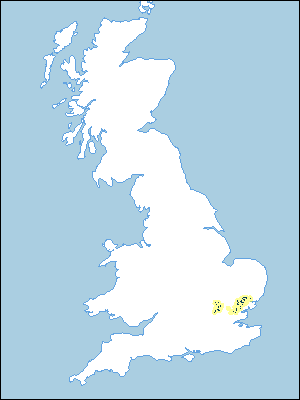
Soil Associations
0582d HORNBEAM 3
Soil and site characteristics
Deep fine loamy over clayey and clayey soils with slowly permeable subsoils and slight seasonal waterlogging. Some slowly permeable seasonally waterlogged fine loamy over clayey soils. Calcareous subsoils in places.
Geology
Chalky till
Cropping and Land Use
Cereals and other arable crops.
Component soil series
| Subgroup | Series name | Percentage | WRB 2006 link |
|---|---|---|---|
| 5.82 | HORNBEAM | 40% | Profundic Chromic Endostagnic Luvisols |
| 5.72 | ASHLEY | 20% | Endostagnic Luvisols |
| 4.31 | FAULKBOURNE | 15% | Clayic Stagnic Luvisols |
| 7.14 | OAK | 10% | Chromic Luvic Stagnosols |
Covers 313 km2 in England and Wales
Soilscapes Classification
| 8 |
Slightly acid loamy and clayey soils with impeded drainage |
0582d HORNBEAM 3
Detailed Description
This association covers 307 km² on flat and gently sloping land along the southern margins of the chalky till in Suffolk and Essex, mainly between Chelmsford and Ipswich, and in Hertfordshire between St Albans and Baldock. Most component soils are fine loamy over clayey with slowly permeable subsoils; they suffer from some seasonal waterlogging. About a third of the soils belong to Hornbeam series, stagnogleyic paleo-argillic brown earths, with red mottled, deeply weathered subsoils, but there are also some similar soils, lacking reddish mottles, belonging to the Kearby series . Locally soils with calcareous subsoils within 80 cm depth occur. These include Ashley series, stagnogleyic argillic brown earths, covering about a fifth of the land and Faulkbourne series, argillic pelosols, which is clayey throughout and has a well structured chalky subsoil. Oak series also occur and these paleo-argillic stagnogley soils, are similar to Hornbeam in texture and degree of weathering. They occupy flat plateau sites and, showing greater mottling, remain waterlogged for longer periods in winter. Local accumulations of thick aeolian silty drift give Hook series. Thinner deposits carry Batcombe soils, similar to Hornbeam series but with fine silty horizons overlying clayey subsoils.
The Hook series is almost stoneless but other constituent soils are slightly flinty in upper loamy horizons and commonly are flinty or very flinty in pockets near the base of these layers. The chalky till subsoil where present, has common very small to medium rounded chalk stones.
In the large blocks of the association in Suffolk and Essex, soil variability is caused by small variations in drift thickness which affect the soil water regimes. Here the main soils are Hornbeam series and the similar Ashley, Faulkbourne, Oak and Kearby series. Near Chelmsford the soils are more varied with inclusions of Hook and Batcombe series. In Hertfordshire, the underlying till is more variable and is patchily distributed on the dissected plateau between 100 and 125 m O.D. West of Stevenage the subsoils of Hornbeam series become redder as the underlying till passes to an older, more weathered, plateau drift. The proportion of Hornbeam soils increases towards the south-west. In the Vale of St Albans the till is generally thin over gravels and, in places, is discontinuous as near Letty Green.
Soil Water Regime
Most of the soils have a slowly permeable clayey subsoil and suffer some degree of waterlogging (Wetness Class II to III). They respond well to drainage which is usually necessary for continuous arable use. Oak soils are wetter (Wetness Class III or IV) and less easily improved. Droughtiness risk varies with locality. There is generally a droughtiness class difference between the slightly wetter western district around Welwyn, and the drier east where soil moisture deficits are greater by 30 mm or more (Table 29). Grass production is restricted by droughtiness in all localities.
Cropping and Land Use
Autumn conditions are generally good for landwork with an adequate period to establish autumn-sown crops. Opportunities for spring landwork are more restricted particularly in wet seasons and on the Oak soils, especially in the wetter parts of Hertfordshire. Farming is based on cereals with oilseed rape, peas and beans as subsidiary crops. Some potatoes are grown. There are some orchards in Essex and south Suffolk. In Herts, where there is a higher proportion of Oak soils than elsewhere, deciduous woodland is common. The soils are naturally acid and require periodic liming.
0582d HORNBEAM 3
Distribution Map
 |
Note that the yellow shading represents a buffer to highlight the location of very small areas of the association.
Keys to component soil series
Eastern Region
 |
Typical Landscapes
Eastern Region
 |
All information Copyright, Cranfield University © 2025
Citation: To use information from this web resource in your work, please cite this as follows:
Cranfield University 2025. The Soils Guide. Available: www.landis.org.uk. Cranfield University, UK. Last accessed 25/04/2025
